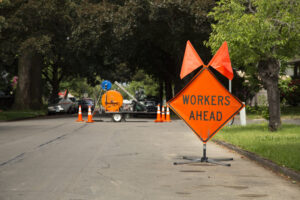The National Institute for Occupational Safety and Health (NIOSH) and its partners will observe a National Work Zone Awareness Week from April 15 to April 19 focused on the safety of road construction workers, Director John Howard announced March 4 in the institute’s eNews newsletter.
The event aims to encourage safe driving through highway work zones, reminding drivers they can protect themselves and workers by slowing down, avoiding distractions, and being alert while driving.
During Work Zone Awareness Week, many construction workers and employers will participate in a National Stand-Down to Prevent Struck-by Incidents. The industry observes work pauses for worker safety—referred to as “safety stand-downs”—that often include safety-specific “tailgate talks.” There’s also an annual “stand-down” focused on preventing falls in construction.
NIOSH research
NIOSH also announced the results of recently completed studies, one on the effects of physical job demands during pregnancy and another on the workers’ compensation costs of occupational hearing loss.
A review of studies published from 1990 to 2022 found evidence that heavy lifting (22 pounds or more) and postural load (bending at the waist, working with hands over the shoulders) were associated with greater risks of pelvic musculoskeletal pain that both limited function and increased sick leave use among pregnant workers. As lifting frequency increased, both risks greatly increased. Additionally, prolonged standing was associated with double the risk of sick leave.
The review findings suggest that pelvic musculoskeletal pain that limits function is a unique health condition related to physical job demands during pregnancy. Researchers emphasized the importance of designing work to reduce exposure during pregnancy to known physical hazards to prevent musculoskeletal injury and sustain the ability to work.
Another group of NIOSH researchers examined 12,708 workers’ compensation claims for occupational hearing loss from 37 states and the District of Columbia from 2009 to 2013.
While most workplace hearing loss goes uncompensated by the workers’ compensation system in the United States, researchers found that the costs associated with occupational hearing loss claims averaged $60 million per year in 2013 dollars, ranging from $49 million to $67 million. The average annual number of claims was 4,965 and ranged from 4,114 to 5,986.
Nearly half of the industry/occupational groups with at least 50 occupational hearing loss claims were in manufacturing. The highest number of claims occurred in the following groups:
- Aviation (all other employees and drivers)—922 claims,
- Coal mining (not otherwise classified)—715 claims, and
- Coal mining (surface and drivers)—347 claims.
NIOSH announced the publication of a special issue of the American Journal of Public Health highlighting the mental health crisis among healthcare workers titled “Health Worker Mental Health: From the Current Crisis to a Sustainable Future.”
The institute also announced that Lisa Delaney has been appointed the division director of its World Trade Center (WTC) Health Program. Captain Delaney (members of the Commissioned Corps of the United States Public Health Service are uniformed officers) became deputy director of the Emergency Preparedness and Response Office in 2010 and associate director in 2013. NIOSH’s WTC Health Program provides medical monitoring and treatment of health conditions among responders and survivors of the 9/11 WTC attacks.

